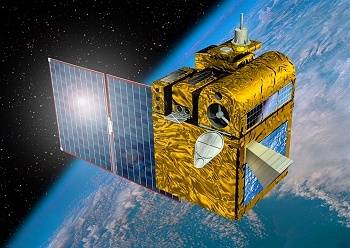You are here : OVSQENObservationSatellite observationsPICARD
- Partager cette page :
- PDF version
PICARD
PICARD is a CNES micro-satellite that measures the total and spectral irradiance of the sun, the variation in its diameter and its sphericity as a function of solar activity and its modes of vibration (helioseismology). The objective is to study solar variability in order to improve models of the solar atmosphere and to assess the impact of solar variability on climate, as well as to carry out new investigations in helio-seismology.
The micro-satellite has 3 instruments on-board:
the SODISM (SOlar Diameter Imager and Surface Mapper) multi-wavelength imager under the responsibility of LATMOS,
the Belgian SOVAP (SOlar VAriability PICARD) and Swiss PREMOS (PREcision MOnitor Sensor) instruments for the measurement of total and spectral irradiance.

PICARD was launched in June 2010. The Picard mission also includes a ground segment (PICARD-SOL) installed on the Calern plateau, under the responsibility of the Côte d'Azur Observatory (OCA) which includes an extra SODISM model (SODISM-II) as well as instruments characterising atmospheric turbulence (MISOLFA-Franco-Algerian Solar Image Monitor) and atmospheric transparency.
Calern PAPS photometer data (PICARD-SOL Automatic Photometer) are available on the AERONET network (AErosol ROboticNETwork). The objective is to study the feasibility of monitoring the long-term variation of the solar diameter from the ground.
The micro-satellite has 3 instruments on-board:
the SODISM (SOlar Diameter Imager and Surface Mapper) multi-wavelength imager under the responsibility of LATMOS,
the Belgian SOVAP (SOlar VAriability PICARD) and Swiss PREMOS (PREcision MOnitor Sensor) instruments for the measurement of total and spectral irradiance.

PICARD was launched in June 2010. The Picard mission also includes a ground segment (PICARD-SOL) installed on the Calern plateau, under the responsibility of the Côte d'Azur Observatory (OCA) which includes an extra SODISM model (SODISM-II) as well as instruments characterising atmospheric turbulence (MISOLFA-Franco-Algerian Solar Image Monitor) and atmospheric transparency.
Calern PAPS photometer data (PICARD-SOL Automatic Photometer) are available on the AERONET network (AErosol ROboticNETwork). The objective is to study the feasibility of monitoring the long-term variation of the solar diameter from the ground.
OSU : OVSQ, OCA, IAS
Status: Observation Service approved by INSU/ASTRO (SO6)
Laboratory in charge: LATMOS
Scientific Manager: Alain Hauchecorne (alain.hauchecorne@latmos.ipsl.fr)
Laboratory in charge: LATMOS
Scientific Manager: Alain Hauchecorne (alain.hauchecorne@latmos.ipsl.fr)




